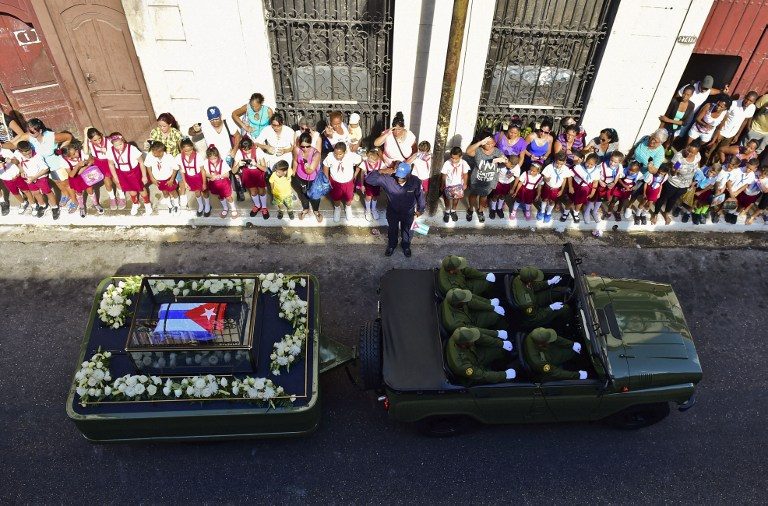SUMMARY
This is AI generated summarization, which may have errors. For context, always refer to the full article.

HAVANA, Cuba – A military jeep carrying the ashes of late communist leader Fidel Castro left Havana on a 4-day journey across Cuba on Wednesday, November 30, with hundreds of thousands of flag-waving islanders bidding farewell along the route.
After two days of tributes to Castro in Cuba’s capital, the “caravan of freedom” departed on a 950-kilometer (590-mile) trek retracing the route of his revolution’s victory tour of 1959.
The flag-covered urn rested on a small olive-green trailer behind the jeep, flanked by white flowers and protected by a glass case, as Havana bid farewell to the man who ruled the island with an iron fist for almost half a century.
The huge crowds chanted “I am Fidel!” and “Viva Fidel!” as the convoy headed on a long trip through the countryside that will end with a burial in the eastern city of Santiago de Cuba on Sunday, December 4.
Senior officials of the government and Communist Party, as well as Castro’s longtime partner Dalia Soto del Valle, attended the farewell ceremony at the armed forces ministry before the caravan headed out.
Cubans were observing the fifth of 9 days of mourning for Castro following his death on Friday, November 25, at age 90. Castro ruled from 1959 until an illness forced him to hand power to his brother Raul in 2006.
Dissidents call Castro a dictator who jailed opponents but others in Cuba praise his legacy of providing free education and health care to Cubans while defying the US “empire.”
“I come from a poor family. I am black. In another era, I wouldn’t have had the opportunity to be who I am today,” said Maria Gonzalez, a 31-year-old computer engineer.
Elsewhere along the route, a tearful Esperanza Pares, 86, said it was “moving to say goodbye to a person who meant so much but who lived long enough to accomplish what he wanted.”
The urn will be laid to rest at a cemetery in Santiago de Cuba, next to the mausoleum of 19th century independence hero Jose Marti.
Che Guevara
Castro’s ashes were taking the reverse route that his band of guerrilla fighters took between January 2-8, 1959, to celebrate their defeat of US-backed dictator Fulgencio Batista.
The convoy will make a symbol-filled stop on Wednesday, November 30, in Santa Clara, where the ashes of his Argentine comrade-in-arms, Ernesto “Che” Guevara, rest.
Castro met Guevara in 1955 while in exile in Mexico, and the young doctor joined Fidel and Raul on the boat that took them to Cuba a year later.
Guevara won a crucial battle in Santa Clara in 1958, derailing an armored train and taking the city.
Guevara was given high-ranking positions in the government but he left in 1966 to lead a guerrilla expedition in Bolivia, where he was executed a year later.
His remains were found 3 decades later and taken to Santa Clara, now home to a huge statute of Che and a museum dedicated to the revolutionary icon.
“His death seemed like something incredible to me. In fact, I don’t know, something that one can never get used to,” Fidel Castro once told a Spanish journalist, admitting that he occasionally had dreams in which he spoke with Guevara.
Uncertain future
As the country ponders its future without Fidel Castro, attention is turning toward Raul and whether he will undertake deeper economic reforms after enacting modest changes in recent years.
The 85-year-old general, who has vowed to step down in 2018, has also restored diplomatic relations with his brother’s eternal enemy, the United States.
“If Fidel’s death results in reforms in Cuba speeding up a little, the rapprochement with the United States could be energized,” said Michael Shifter, president of the Washington-based Inter-American Dialogue think tank.
“It’s an opportunity to strengthen bilateral relations, but a lot will depend on what happens within the Cuban government,” he said.
US President-elect Donald Trump threatened this week to halt the detente that was begun by US President Barack Obama if the Castro government doesn’t offer a “better deal” to the Cuban people.
Obama did not join other foreign leaders at a massive rally for Fidel Castro in Havana late Tuesday, November 29, instead sending aides as the White House voiced lingering concerns about the human rights situation in Cuba.
Tuesday night’s rally capped two days of tributes in Havana where hundreds of thousands were encouraged by the government to view a shrine to Castro at the capital’s Revolution Square.
Leaders from Latin America, Africa and the Caribbean joined the commemoration, but many skipped the event, highlighting the divisive legacy of the Cold War icon. – Rappler.com
Add a comment
How does this make you feel?
There are no comments yet. Add your comment to start the conversation.